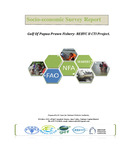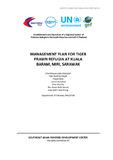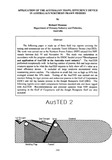| dc.date.accessioned | 2019-10-18T08:56:24Z | |
| dc.date.available | 2019-10-18T08:56:24Z | |
| dc.date.issued | 2016 | |
| dc.identifier.citation | Unasi, R. (2016). Socio-Economic Survey Report Gulf Of Papua Prawn Fishery- REBYC II CTI Project. Training Department, Southeast Asian Fisheries Development Center | |
| dc.identifier.uri | http://hdl.handle.net/20.500.12067/1012 | |
| dc.description.abstract | Gulf of Papua Prawn Fisheries (GoPPF) has come a long way since its development in the early years preceding Papua New Guinea’s independence from Australia. It started in 1969 and became PNG’s largest export fisheries apart from tuna. Prawn alone contributes significantly to the economy annually, earning between K2.5 million to K28 million or US$ 1.5 to US$ 11.5 million per annum. In fact, PNG’s prawn industry is very small compared to other countries in Asia. This is due to management regimes that limit all trawlers operating each season at 15 for the Gulf of Papua region (GoP).
Over the course of the years, there is concern for ecological well-being of the GoP marine ecosystem including other similar ecosystems within the Asia-Pacific region. This ecosystem is pristine with kilometers of estuary, mangroves with nipa palm and associated wetland forest. The pristine ecosystem provides perfect spawning environment for shrimp and brackish water fish species such as barramundi, black bass and mud crabs amongst others. Given this background GoPPF management plan (first drafted in 1998) determines sustainable use of the shrimp resource within the region. However, over time certain management measures have not taken into consideration current technological changes in fishing methods, gear and other thematic threats that compromise the marine ecosystem.
The Strategies for trawl fisheries bycatch management project (REBYC-II CTI) has provided the avenue to re-look at the way GoPPF has been operating in consultation with relevant government, local authority and community interest groups. Within the facets of this program, fundamental areas of assessment within the marine ecosystem of GoP needed extensive social, economic and cultural study. The outcomes of the enquiry will guide specific policy changes, if need be.
A survey team was mobilized in October 2015 and again in November-December 2015 to carry out a survey into coastal communities of the GoP, specifically enquiring with local stakeholders on social and economic profiles of the GoPPF industry. Findings of the survey contained herein determined aspects of the community’s social and economic outlook targeting:
income level from bycatch utilization amongst other income sources;
views on prawn trawling and its associated activities as a whole;
involvement of women in the fishery sector within the GoP;
baseline household and biodata information;
involvement with government and other state players;
opinion on level of assistance forthcoming from relevant authorities including NFA (National Fisheries Authority) and provincial officers amongst others.
Twenty-one communities from three Local Level Government (LLG) areas of Kerema district were covered in this survey. A total of 300 community consultation guide (interview schedule) with another 50 questionnaires each for trawler crew and local government staff were used to collect information contained in this report. A turnover of 281 response (94%) or feedback was completed by 14 enumerators over the duration of this study. Prawn trawler crew returned 18 completed questionnaires while 24 government and fishery officers filled questionnaires targeting technical officers’ views.
Given the results presented in this report, it can be summarized that benefits from GoPPF does not trickle down to the coastal communities despite the communities owning much of the resource. Furthermore, the ability of government agency and local initiatives to assist locals to tap into the resource is significantly lacking. Seventy-two percent (72%) of respondents recognize the fact that they are observers in the prawn industry while 35% of total respondents were women folks who are either directly involved in bycatch utilization and/or artisanal fishing within the waters of GoP. Additionally, impediments in education, infrastructure and social services are noted as findings of this enquiry.
Generally, significant percentage of marine biota is recorded as bycatch/discards (80%-95%) amongst the target prawn species. The bycatch constitutes a good portion of coastal populace protein source and income source while a massive fraction of it is discarded as waste into the sea. | en |
| dc.language.iso | en | en |
| dc.publisher | Unasi for National Fisheries Authority. SEAFDEC,FAO ,REBYC-II CTI ,NFA | en |
| dc.subject | Socio-economic | en |
| dc.subject | Gulf Of Papau | |
| dc.subject | Prawn Export Volume | |
| dc.subject | GoPPF | |
| dc.subject | Report Gulf Of Papua Prawn Fishery | |
| dc.title | Socio-Economic Survey Report Gulf Of Papua Prawn Fishery- REBYC II CTI Project. | en |
| dc.type | Technical Report | en |
| dc.contributor.corporateauthor | Unasi for National Fisheries Authority. | en |
| dc.contributor.corporateauthor | SEAFDEC,FAO | en |
| dc.contributor.corporateauthor | REBYC-II CTI | en |
| dc.contributor.corporateauthor | NFA | en |




